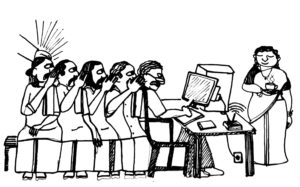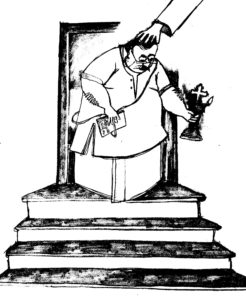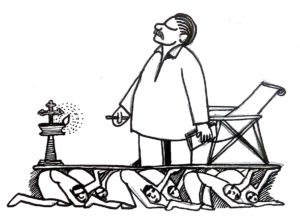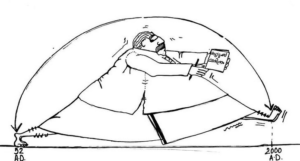Accompanied by original sketches, Nidhin Donald presents a tongue-in-cheek perspective of the trend of producing written ‘family histories’ among Syrian Christians in Kerala.
Nidhin Donald
Family history writing is a trend among Syrian Christians (and a few others) in Kerala. In the last five years, I have gone through several copies of such histories—both hard and soft—to analyze their contents, contexts and actors. The family historian or kudumba charitrakaaran is a key figure in this literary exercise. Who are these amateur historians and how do they husband their family’s history? Let me try and answer this question.

A man standing beside you at a bus stop is your ‘blood-relative’, but you don’t recognize him. You migrate to a new city in the U.S. and people want to know your ‘Hindu name’. You are in Delhi and a close friend thinks you are not the ‘right kind’ of Christian. Your grandchild has no qualms marrying outside the community and you fail to impress on them that endogamy is good. Your old-time tenants and servants, their children and grandchildren don’t seem to acknowledge you enough—these are some of the concerns which move the Nasrani family historian. Typically a well-resourced, affluent man, a transnational migrant or retired professional (he could also be a landlord or planter, even), the family historian responds to this ‘crisis’ by mobilizing the kin—anew. With the time, money and networks at his disposal, he travels far and wide to collect old stories and to fill in genealogical gaps.
In the early 20th century, when it all began, communication was difficult and thus his attempts were short-lived. Things changed after the oil-boom migration of the 1970s; Syrian families now had more money (and land). This made the historian’s investments sustainable. Today, we come across YouTube videos that capture the NRI family historian’s ‘search for roots’—nasrani style. Having collected all these stories—many of which were orally handed down over generations—he sits down to write them. Today, this writing is software-mediated. The book, thus prepared, becomes a centrepiece of the family association or kudumbayogam. It is formally launched, displayed in public libraries, affluent living rooms and uploaded on websites. The family historian transforms fuzzy, obsolete stories into something more permanent.

What do we find in a typical family history? Mr. Family Historian is not a man who acts on his own. He is the modern prototype of the filial collective. His words stand for the whole. He may begin with universal appeals to the ‘family’, only to enter an elaborate polemic on distinction and hierarchy. Early on in the story, he fixes the caste identity of the kin network. This is done with a simple repetition of the standard (but highly contested) brahmin-conversion myth of 52 AD. But he doesn’t stop at that. This beginning is then padded with fragments of royal patronage, migration, sometimes persecution, land ownership, church constructions, miracles and even physical features of the ancestors. A multi-storeyed social structure with the kin on the top (or among the top) is forged with or without competence. In such a structure, the family historian clearly identifies his friends, foes, servants, and slaves—from the past and for the future.

The time between the apostolic beginning and late 18th or early 19th century is a black box for the amateur historian. They rush it up or sometimes take giant temporal leaps. They can’t help this as there aren’t many sources to go back to. Nevertheless, they believe that their bloodlines remained as ‘pure’ as ever through the centuries. After all, family history is also an exercise in ignorance and blind spots.

Mr. Family Historian harks back to medieval titles, privileges, and rituals to tell us where he stands on the social ladder. In this process, he shows others their place as well. Quite often, the historian claims entry into the Hindu social order by exploring his kin’s duties as ritual purifiers for upper-caste landlords and temples. He conducts interviews with almost-dead landlords to reconstruct this glorious past. He then covers everything with ‘religious syncretism’ and ‘communal harmony’ to somehow defuse the ugliness of the ritual.

For Mr. Family Historian and many others, old ways are never old. They are reinvented, at least as stories, to keep the family together. Prejudice and supremacism, when cultivated well, can bind the kin like no other adhesive. They objectively reproduce class, caste, religion, and gender—often without any direct coercion. One wonders if there is a better pastime for the leisure class than becoming Mr. Family Historian.
About the Author: Nidhin Donald is a PhD scholar with JNU, Delhi. He works on Syrian Christian identity politics with a focus on family histories, websites and videos. All the illustrations in this write-up are his own. Some of them appeared in his MPhil dissertation. He has previously written for Ala here.

Fantastic article and superbly funny and true.
I am a 30M NRI syrian christian who is currently half way through my own family history but told in a magical realism ‘rushdie-esque’ narrative. Hopfully i wont strumble into the pitfalls of my elder peers which you have hilarously outlined for me 🙂
Thanks for this article!
Dear Aaron, I would like to know more about your family history writing process. My email ID : [email protected]
There are family histories written by Dalit Christians tracing their slave past. Few such histories have been published. There are Syrian Christian family history tracing the exact date of landing made St Thomas.
where can one access the articles you have mentioned?